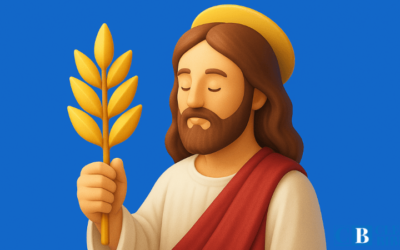Why was the most influential story of all time told from four different perspectives?
Far from being an unnecessary repetition, the four gospels: Matthew, Mark, Luke and John offer a comprehensive, multifaceted and deeply transformative vision of the life and work of Jesus Christ. Each, with its own style, purpose, and specific audience, reveals a unique face of the same Savior.
Jesus as King, Servant, Savior, or Eternal Word? They all portray him, but each Gospel highlights him in a unique way.
In this article we will explore:
- Who wrote each gospel and for what purpose?
- Why are three so similar and one so different?
- What message do you have for 21st-century readers?
Get ready to rediscover the stories that changed history… and that can change yours.
What are the gospels and why are they so important?
How would we know the life, teachings, and miracles of Jesus without the Gospels?
The Gospels are the first four books of the New Testament. Matthew, Mark, Luke and John and constitute the heart of the Christian message. The word “gospel” means “good news”, and each of these writings has the purpose of announcing the life, death and resurrection of Jesus Christ, the Son of God.
These stories are not conventional biographies, but spiritual and historical testimonies Inspired by God to show that Jesus is the promised Savior. The Gospels present Christ to us from different angles, and together they form a rich, complete, and transformative picture.
Why are there four and not just one?
Instead of a single unified account, God allowed four different authors Each person with their own style, context, and audience writes from their own perspective. This does not create a contradiction, but rather complementarity.
- Matthew writes for the Jews, showing Jesus as the Messiah.
- Mark writes for the Romans, focusing on action and power.
- Luke addresses the Greeks, highlighting the humanity and compassion of Christ.
- John writes for everyone, revealing the divinity of Jesus with theological depth.
Having four gospels allows capture the fullness of Jesus' character and mission from different cultural and spiritual contexts, enriching our understanding of his person.
How they relate to each other and what makes them unique
Matthew, Mark and Luke are known as the synoptic gospels (“common view”) because they share many events, lessons, and narrative structures. They often present the same stories, albeit with particular nuances.
Juan, on the other hand, It departs from the chronological and optical approach, offering a more reflective and symbolic look at the identity of Jesus as the eternal Word, the Light of the world and the Bread of Life.
Each gospel has a unique voice:
- Matthew: the prophetic fulfillment.
- Marcos: the urgency of the Kingdom.
- Luke: universal compassion.
- Juan: divine revelation.
Read together, They do not contradict each other, but rather harmonize each other to offer us a complete vision of the Gospel that transforms lives.
The Gospel according to Matthew
Author, date and recipients
Traditionally attributed to Matthew (Levi), one of the twelve apostles and former tax collector, this gospel was probably written between the 60s and 80s AD, in a context where the church had already spread but maintained strong Jewish roots.
Matthew wrote mainly for a Jewish audience, as evidenced by its emphasis on the fulfillment of the Law, genealogies, and Old Testament prophecies.
Main Focus: Jesus as King and Promised Messiah
Matthew presents Jesus as the King of the Jews, he Prophesied Messiah, a direct descendant of Abraham and David. It begins with a royal genealogy (Matthew 1:1–17) and repeatedly emphasizes that events occur “that what was spoken through the prophet might be fulfilled.”
The gospel is full of references to Kingdom of Heaven, a key concept that highlights the authority, justice, and messianic hope of the reigning Christ.
Literary characteristics and structure of the gospel
The Gospel of Matthew is organized thematically, with five great speeches of Jesus, which some see as a symbolic parallel to the five books of Moses (Pentateuch):
- The Sermon on the Mount (chapters 5–7)
- Missionary Instructions (chap. 10)
- Parables of the Kingdom (chap. 13)
- Teachings on Community (Chapter 18)
- Eschatological discourse (chapters 24–25)
Furthermore, Matthew combines storytelling with teaching, highlighting the power of works and the authority of words of Jesus.
Matthew and the prophecies of the Old Testament
Matthew quotes the Old Testament more than any other gospel, stressing that Jesus is the full fulfillment of the Law and the Prophets.
Notable examples:
- Virgin Birth (Isaiah 7:14)
- Birth in Bethlehem (Micah 5:2)
- Flight to Egypt (Hosea 11:1)
- Massacre of the Innocents (Jeremiah 31:15)
This gospel connects the old covenant with the new, revealing Jesus as the living fulfillment of Israel's messianic hope.
The Gospel according to Mark
Author, origin and historical context
Marcos, also known as Juan Marcos, was a companion of Paul and later a close collaborator of Peter. His gospel is largely based on the stories and teachings of the apostle Peter, making it a first-line testimony.
It is considered the oldest gospel, probably written between the years 55 and 70 AD, addressed to Christians in Rome who were facing persecution and needed a message of action, power and hope.
Main Focus: Jesus as a Suffering and Powerful Servant
Mark's main emphasis is to show Jesus as the obedient Servant of God (Mark 10:45), who came not to be served, but to serve and give his life by many.
Jesus is portrayed as a man of action rather than speech. His works and miracles highlight his divine authority and compassion, even though his path inevitably leads to suffering and the cross.
Direct, brief and dynamic style
Mark is the most gospel short, agile and visual. He frequently uses expressions like “and then”, “immediately”, “instantly”, which creates an intense and focused narrative rhythm.
It is ideal for new readers or for presenting the gospel to people who value action rather than theological explanation.
Furthermore, it omits the genealogy and birth of Jesus, and begins directly with his public ministry.
Mark and discipleship in action
A central theme in Mark is the cost of discipleship. Jesus not only performs miracles, but calls to follow him with renunciation and faith:
- Take up the cross (Mark 8:34)
- Losing one's life for the gospel (Mark 8:35)
- Serving others as the Master did (Mark 10:43–45)
This gospel challenges its readers to go from viewers to active followers, reflecting Jesus not only in words, but in deeds.
The Gospel according to Luke
Author, purpose and research method
Luke was physician and traveling companion of the apostle PaulHe was not an eyewitness to the events, but he carefully gathered information from direct sources (Luke 1:1–4), including eyewitnesses and servants of the Word.
Its stated purpose is to offer an orderly and reliable account of the life of Jesus, addressed specifically to a believer named Theophilus, and in general to Gentile (non-Jewish) readers who were seeking a historically grounded faith.
Lucas is the only Gentile author of the New Testament, and his gospel is the longest in terms of verses.
Main focus: Jesus as Savior of all
Luke portrays Jesus as the Universal Savior, not only for Jews, but also for Gentiles, sinners, women, the poor and marginalizedJesus is presented as the Son of Man who brings good news of great joy for all the people (Luke 2:10).
His genealogy goes back to Adam, not only to Abraham, showing that Jesus came for all humanity.
Inclusion of exclusive parables (such as the prodigal son)
Luke contains more parables than any other gospel, including some of the best known and loved:
- The Prodigal Son (Luke 15)
- The Good Samaritan (Luke 10)
- The Rich Fool (Luke 12)
- The Pharisee and the Publican (Luke 18)
These parables illustrate God's love, mercy, justice, and true repentanceHis narrative style moves and transforms the heart.
Luke and his emphasis on the marginalized and women
Lucas shows a singular interest in:
- The women: Mary, Elizabeth, Anne, Martha, Mary of Bethany and many more have a leading role.
- The poor: Jesus proclaims good news to the poor and denounces injustice.
- The sinnersZacchaeus, the thief on the cross, and other social outcasts are exalted as examples of faith.
- The Samaritans and Gentiles: receive praise and attention in the message of salvation.
This approach reflects Jesus as the Messiah who breaks down social barriers and extends grace to all.
The Gospel according to John
Author, symbolism and elevated theology
John, the son of Zebedee and brother of James, was one of Jesus' closest disciples. His gospel was written later than the synoptics, probably between the years 85 and 95 AD
Unlike the other gospels, John does not narrate many known events, but focuses on the deep spiritual meaning of which it does include. His gospel is full of symbolism and lofty theological statements, as:
- Jesus is the Light of the world
- He Word made flesh
- He Good Shepherd, he Bread of life, the True Vine
Main focus: Jesus as Son of God, the eternal Word
From the first verse, John makes his intention clear:
“In the beginning was the Word, and the Word was with God, and the Word was God.” (John 1:1)
John presents Jesus as the Son of pre-existent God, fully divine and fully human, whose mission is to reveal the Father and give eternal life to all who believe.
The goal of the gospel is explicit in John 20:31:
“So that you may believe that Jesus is the Christ, the Son of God, and that by believing you may have life in his name.”
Miracles as “signs” and profound speeches
John does not use the word “miracles” but “signs”, because every work of Jesus points to a greater spiritual truthAmong them:
- Water turned into wine
- The healing of the man born blind
- The resurrection of Lazarus
In addition, it includes long theological speeches and deep conversations, such as:
- With Nicodemus (John 3)
- With the Samaritan woman (John 4)
- The Bread of Life Discourse (John 6)
- The Priestly Prayer (John 17)
John and the call to faith and eternal life
The Gospel of John is imbued with personal calls to believeThe word “believe” appears more than 90 times, highlighting that Faith in Jesus as the Son of God brings eternal life.
Also noteworthy:
- He new birth as a spiritual condition (John 3)
- The work of the Holy Spirit as a guide and comforter
- The Eternal life not only as a future destination, but as a present experience
John invites the reader not only to know Jesus, but to believe in Him, abide in Him, and live in Him.
Comparison between the four gospels
Key similarities and differences
The four gospels share the same fundamental purpose: present the life, death, and resurrection of Jesus ChristHowever, they do it from different perspectives, adapted to their audiences and theological objectives:
- Similarities:
- They narrate the miracles, teachings and passion of Jesus.
- They show their compassion, authority and divinity.
- They culminate in the crucifixion and resurrection.
- Differences:
- Narrative style, chronological order, thematic focus.
- Some parables, miracles, and events appear in only one or two gospels.
- Each author highlights unique aspects of Christ's character and mission.
These differences enrich the evangelical panorama and allow a more complete understanding of the message of salvation.
The Synoptic Gospels (Matthew, Mark, Luke)
The Gospels of Matthew, Mark and Luke are known as “synoptics"because they can be seen in parallel (from the Greek synopsis = joint vision). They share:
- Much of the content, structure and vocabulary.
- A narrative centered on Galilee, with emphasis on the deeds of Jesus.
- Historical, practical and didactic approaches.
It is believed that Mark was the first to be written, and that Matthew and Luke used it as a source, along with other oral or written traditions.
The Gospel of John: Independent and Complementary
The Gospel of John does not follow the structure or focus of the synoptics. It focuses on:
- The ministry of Jesus in Jerusalem more than in Galilee.
- Long speeches, personal encounters, and “I Am” statements.
- A highly symbolic language and deep theology.
John complements the synoptics by revealing the eternal and spiritual dimension of the Messiah, focusing more on who Jesus is in what he did.
Contradictions or complementary perspectives?
The differences between the gospels they are not real contradictions, but complementary perspectives which reflect:
- Different audiences (Jews, Romans, Greeks, universal church).
- Specific theological themes according to each author.
- Intentional selection of episodes to highlight key truths.
Just as four witnesses in a trial can relate the same event from different angles, the gospels offer us a richer, more three-dimensional vision of Jesus Christ.
Common theological themes in the gospels
The Identity of Jesus: Messiah, Son of God, Redeemer
All the gospels clearly state that Jesus is the Christ, the Anointed One, the one awaited by the prophets. It is:
- Real Messiah (Matthew),
- Mighty servant (Marcos),
- Compassionate Savior (Luke),
- Divine and eternal Word (Juan).
These titles reflect his redemptive mission and his divine-human nature, fulfilling the Scriptures.
The Kingdom of God and its arrival in Christ
Jesus preached:
“The Kingdom of God has come near; repent and believe in the gospel.” (Mark 1:15)
This Kingdom:
- It is neither political nor earthly, but spiritual and eternal.
- It is present in the life, words and works of Jesus.
- Calls believers to live under his lordship, with values opposite to those of the world.
In each gospel, The Kingdom is the central theme of Christ's ministry.
The message of salvation by grace and faith
Jesus did not come to establish one more religion, but to offer free salvation, by grace, for all who believe.
- He forgives sinners (Luke 7:48),
- Heals by faith (Matthew 9:22),
- He declares: “He who believes in me has eternal life” (John 6:47).
The personal faith in Jesus It is the channel to receive his forgiveness, his peace and his life.
Death and resurrection as the central axis
All the gospels converge in the culminating moment of redemptive history: the passion, death and resurrection of Jesus.
- It is not a tragic end, but the glorious fulfillment of his mission.
- The cross was not defeat, but victory over sin and death.
- The resurrection guarantees hope, new life and redemption.
The gospels were written to lead us to the cross… and beyond the empty tomb, towards a living faith in the risen Christ.
How were the gospels formed and transmitted?
Oral tradition and apostolic testimony
Before being written, the gospels were transmitted orally by Jesus' disciples and eyewitnesses. This oral tradition was:
- Alive and communal, reinforced in the preaching and teaching of the churches.
- Carefully preserved, as part of the apostolic testimony.
- Focused on the words, deeds, death and resurrection of Jesus.
The apostles passed on what they saw and heard (1 John 1:1), and their accounts were later recorded by authors such as Mark (from Peter), Luke (researcher), Matthew (direct witness) and John (close apostle).
The inspiration of the Holy Spirit
The gospels are not mere historical documents, but Scripture inspired by God (2 Timothy 3:16).
- The Holy Spirit guided the authors in the selection, organization and writing of content.
- He guaranteed that what was written was true, faithful and without error in his message.
- This inspiration did not cancel out the style or personality of each author, but rather He used them as conscious instruments to reveal divine truth.
Canonization and inclusion in the New Testament
The four gospels were recognized early by the church as authoritative Scripture. Criteria for inclusion in the canon:
- Apostolic origin or direct relationship with the apostles.
- Doctrinal coherence with the teachings of Christ.
- Liturgical and universal use in the early Christian churches.
Unlike the apocryphal or late gospels, Matthew, Mark, Luke and John They always enjoyed acceptance and reverence in the early Christian community.
Historical and spiritual value of the Gospels
The gospels have a double value:
- Historical, because they preserve ancient testimonies about the life of Jesus with precision and cultural context.
- Spiritual, because they reveal the living Christ who continues to transform lives.
Are reliable sources of faith and knowledge, which connect the past with the present and remain the foundation of the Christian faith throughout the world.
Practical application of the gospels today
Reading the Gospels as a Disciple
It is not enough to know the gospels as literature; we must read them. as disciples who follow Jesus:
- Hear his words as current and alive.
- Observe his character to imitate him.
- Respond with faith, obedience, and daily transformation.
Reading the gospels is listen to the Master's voice and walk behind Him.
How to apply the teachings of Jesus in daily life
Jesus did not speak to be admired, but to to be obeyedHis teachings are:
- Practices for forgiveness, generosity, truth, and love.
- Guide for our relationships, decisions and priorities.
- Light for every circumstance, from home to work.
Apply his teachings makes us wise, free and full (Matthew 7:24–25).
The transformative power of the gospel in today's culture
The gospels do not lose their validity:
Jesus continues to transform hearts, communities and cultures.
- Exchange broken lives for restoration.
- Transform injustices through active compassion.
- It gives real hope to a hurting world.
The gospel is revolutionary because it responds to the deepest needs of human beings, yesterday and today.
The Gospels as a spiritual guide for believers and seekers
For the believer, the gospels are daily nourishment, doctrinal foundation and source of spiritual renewal.
For the search engine, they are a window to God's truth, grace, and love incarnated in Jesus.
Whatever your background, The Gospels invite you to encounter Christ and let his message transform your eternity.
Book recommendations for further study
📘 “Jesus According to the Gospels” – José Antonio Pagola
A clear and deeply researched work that offers a historical and spiritual vision of Jesus based on the four Gospels. Ideal for those who want to better understand Jesus in his original context and current relevance.
📘 “New Testament Bible Commentary: Gospels” – William Barclay
An essential classic with simple and profound explanations, full of cultural, linguistic, and religious context. Each passage comes alive and connects with the reader's daily life.
📘 “A Panorama of the New Testament” – Thomas Lea and David Black
It presents a scholarly yet accessible analysis of each book of the NT. The focus on the gospels is Structured, informative and useful for Bible studies, preaching or teaching.
Frequently Asked Questions about the Four Gospels
Who wrote the four gospels?
- Matthew: apostle and former tax collector.
- Marcos: disciple of Peter and collaborator of Paul.
- Luke: doctor and historian, companion of Pablo.
- Juan: apostle and close eyewitness to Jesus.
Why are there differences between them?
Because each evangelist wrote from his own context, audience and purpose, inspired by the Holy Spirit. They do not contradict each other, but rather complement each other to give a more complete vision of Jesus.
What does it mean that three are synoptic?
“Synoptic” means “overview.” Matthew, Mark and Luke They are synoptic because they share structure, content and narrative style similar. John, on the other hand, is more theological and symbolic.
What was the first gospel to be written?
Scholarly consensus indicates that the first gospel was Marcos, probably written between the years 55 and 70 AD
What does the Gospel of John focus on most?
In revealing Jesus as the Son of God, he Eternal Word made flesh, and highlight faith as a path to eternal life. It uses symbolism and long, deep teachings.
Which gospel contains more parables?
Luke is the one that includes more parables (more than 20), many of them exclusive, such as the prodigal son, he Good Samaritan and the rich fool.
What is the relationship between the Gospels and the life of Jesus?
The gospels are The main historical and spiritual source on the life, teachings, miracles, death, and resurrection of Jesus. They are essential to knowing the real Christ.
Are the gospels historically reliable?
Yes. Although they are not modern biographies, they are based on eyewitness testimony, written within the same generation of events, with internal consistency and archaeological validation.
Which gospel do you recommend reading first and why?
Many recommend starting with Marcos for being brief, direct, and action-oriented. Others suggest Juan for a deeper insight into the divine identity of Jesus.
How do the gospels apply to Christian life today?
The gospels are guide, model, and foundation of the Christian faithThey teach us to live like Jesus, to love like Him, to forgive like Him, and to await His Kingdom with faith and obedience. the disciple's daily compass.
Conclusion
The four gospels are not just ancient pages: they are living doors to the person of Jesus ChristMatthew, Mark, Luke, and John invite us to look at the same Savior from different angles, revealing His humanity, His divinity, His compassion, and His power. Together, they form a symphony of truth that resonates through the centuries and continues to transform lives today.
Whether you are reading for the first time or returning to them as a committed disciple, The gospels have something new to teach you every day: a word, a story, a truth that touches your soul right where you need it most.
Which of the four gospels has impacted your life the most and why?
Leave us your comment and share your experience with the Word that changes hearts.
Discover How the Bible Can Transform Your Life
- Bible Study – explore the teachings of the Bible and find answers to life’s challenges.
- Fundamental Beliefs – delves into the principles that have guided millions through the centuries.
- Spiritual Growth – Strengthen your faith with studies designed to bring you closer to God.

Discover How the Bible Can Transform Your Life
- Bible Study – explore the teachings of the Bible and find answers to life’s challenges.
- Fundamental Beliefs – delves into the principles that have guided millions through the centuries.
- Spiritual Growth – Strengthen your faith with studies designed to bring you closer to God.



























0 Comments